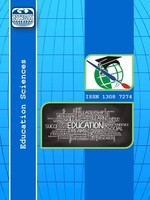THE TEACHER ATTIUDES TOWARD THE LEARNER CONTROL STRATEGY
Constructivism, Elaboration Theory, Instructional Strategies, Learner Control Strategy, Learning Strategies,
ÖĞRENCİ KONTROL STRATEJİSİNE YÖNELİK ÖĞRETMEN TUTUMLARI
Yapısalcılık, Ayrıntılama Kuramı, Öğretim Stratejileri, Öğrenci Kontrol Stratejisi, Öğrenme Stratejileri, ,
___
- Özden, Y. and Şimşek, H., (1998). Behaviourism to Constructivism, Science and Society, April, Turkish World.
- Açıkgöz Ün, K., (2003). Active learning.(4th ed.) İzmir, World of Education Publications.
- Beniger, J.R., (1986). The control revolution: technological an economic origins of the information society. Cambridge, Massachussetts, Harvard University Press.
- McLoughlin, C. and Oliver, R., (1995). Analyzing interactions in technology supportedlearning environments. In R. Oliver & M. Wild (Eds.), Learning without limits, 2 Proceedings of the 13th Annual,National Computers in Education Conference, pp: 49-62. Perth, Western Australia, ECAWA.
- White, R.W., (1959). Motivation reconsidered: The concept of competence. Psychological Review, Volume: 66, Number: 5, pp: 297-333. doi: 10.1037/h0040934
- de Charms, R., (1976). Enhancing Motivation: Change in the Classroom. Irvington Publishers, New York.
- Saban, A., (2005). The process of learning-teaching, Ankara: Nobel Publishing House.
- Reigeluth, C.M. and Stein, R., (1983). Elaboration theory: instructional-design theories and models: An overview of their current status. In C.M. Reigeluth (Ed.), Hillsdale New Jersey: Erlbaum.
- Reigeluth, C.M., (1987). Lesson blueprints based on the elaboration theory of instruction. In C.M. Reigeluth (Ed.), Instructional theories in action: lessons illustrating selected theories and models, pp: 45-288). Hillside, New Jersey: Lawrence Erlbaum Associates.
- Reigeluth, C.M., (1983). Instructional-design theories and models: an overview of their current status. In C.M. Reigeluth (Ed.), Hillsdale, New Jersey: Erlbaum Associates.
- Reigeluth, C.M., (1979). In search of a better way to organize instruction: The elaboration theory. Journal of Instructional Development. Volume: 2, Number: 3, pp: 815. doi:10.1007/BF02984374
- Merrill, M.D., (1984). What Is Learner Control? In R.K Bass, C.R. Dills (Eds.), Instructional Development the State of Art II, pp: 221-242. Dubuque, Louisiana: Kendall/Hunt.
- Gage, N. and Berliner, D.C., (1988). Educational Psychology. Boston, Houghton Mifflin Company.
- Klausmeier, H.J., (1985). Educational Psychology, (5th ed.), New York, Harper and Row.
- Santiago, R. and Okey, J., (1992). The effects of advisement and locus of control on achievement in learner-controlled instruction. Journal of Computer-Based Instruction, Volume: 119, Number: 2, pp: 47-53.
- Lunts, E., (2002). What does the literature say about the effectiveness of learner control in computer-assisted instruction? Electronic Journal for the Integration of Technology in Education, Volume: 1, Number: 2, pp:59-75.
- Fraankel, J.R. and Wallen, N.E., (1993). How to design and evaluate research in education. Singopore, Mc Graw-Hill.
- Başlangıç: 2009
- Yayıncı: E-Journal of New World Sciences Academy
ÖĞRETMEN ADAYLARININ DEMOKRATİK DEĞERLERİ VE BU DEĞERLERİN BAZI DEĞİŞKENLER AÇISINDAN İNCELENMESİ
THE TEACHER ATTIUDES TOWARD THE LEARNER CONTROL STRATEGY
Mahmut Oğuz KUTLU, Şadiye KORKMAZ
Semra TURAN, Halil AYDIN, İlker UĞULU
DİSKALKULİ YAŞAYAN ÖĞRENCİLERE İLİŞKİN ÖĞRETMEN GÖRÜŞLERİNİN DEĞERLENDİRİLMESİ
Mihriban Hacisalihoğlu KARADENİZ
DEMOKRATİK BİR EĞİTİM ORTAMINDA EĞİTİM PROGRAMININ ÖZELLİKLERİ
UYGULAMA OKULLARINDAKİ YÖNETİCİ VE EĞİTİCİ PERSONELİN OKUL DENEYİMİ DERSİNE İLİŞKİN ÖNERİLERİ
Vesile ALKAN, Selçuk ŞİMŞEK, Ali Riza ERDEM
EĞİTİM MÜFETTİŞLERİNİN HİZMET İÇİ EĞİTİM İHTİYAÇLARI
Hacı İsmail ARSLANTAŞ, Metin ÖZKAN
